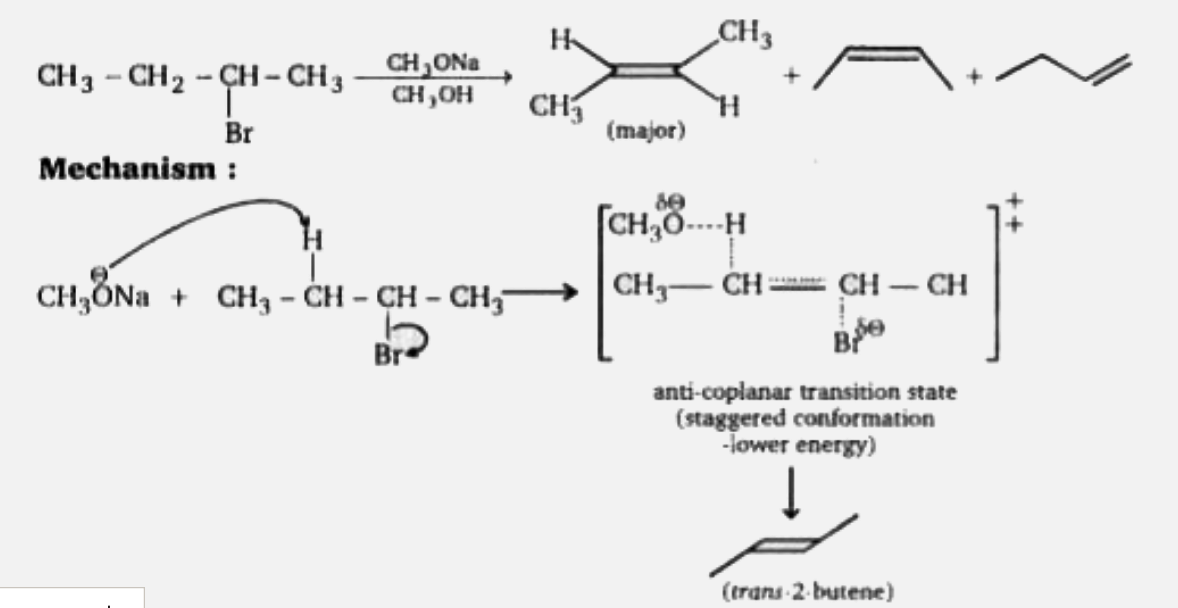Consider the following reactions and answer A and B.

Yield of each step as actually carried out in laboratory is given above each arrow. What is overall yield of the reaction ?Solution in Kannada
0.6
0.21
0.4
0.68
The correct Answer is:B
0.21
Topper's Solved these Questions
- ALDEHYDES AND KETONESBOOK - MS CHOUHANCHAPTER - ALDEHYDES AND KETONESEXERCISE - LEVEL-2
20 Videos
- ALCOHOL,ETHERS AND EPOXIDESBOOK - MS CHOUHANCHAPTER - ALCOHOL,ETHERS AND EPOXIDESEXERCISE - SUBJECTIVE PROBLEMS
1 Videos
- ALKYL HALIDES (ELIMINATION REACTION) BOOK - MS CHOUHANCHAPTER - ALKYL HALIDES (ELIMINATION REACTION) EXERCISE - LEVEL-2
25 Videos
Similar Questions
Select the best choice for example (A to L) from the examples (a to n) given below. Write your choice in the box given.


View Solution
Maximum number of moles of Ac2O consumed by reactant (A) is :
View SolutionComprehension
E2 raction → Elimination bimolecular
In the general mechanism of the E2 reaction a strong base abstract a proton on a carbon atom adjacent to the one of the leaving group. As the abstracts a proton , a double bond forms and the leaving group leaves.

Identify the rate of reaction of given compounds in E2 reaction:

View Solutionphotoyisis of each water molecule in light reaction will yield
View Solution
Yield of each step as actually carried out in the laboratory is given above . What is overall yield of reaction ?
View Solution
How many gms of cyclohexane will be formed in the above rection(Consider the yield to be 100% in each step)?
View Solutionरासायनिक अभिक्रियाओं में वास्तविक लब्धि (Actual yield) सदैव सैद्धान्तिक लब्धि (Theoretical yield)से कम होती है क्यों ?
View SolutionConsider the following reactions, H_(2)(g)+I_(2)(g)hArr2HI(g) In each of the above reaction find out whether you have to increase (or) decrease the volume to increase the yield of the product.
View SolutionConsider the following reactions, CaCO_(3)(s)hArrCaO(s)+CO_(2)(g) In each of the above reaction find out whether you have to increase (or) decrease the volume to increase the yield of the product.
View SolutionConsider the following reactions, S(s)+3F_(2)(g)hArrSF_(6)(g) In each of the above reaction find out whether you have to increase (or) decrease the volume to increase the yield of the product.
View SolutionConsider the following reactions, H_(2)(g)+I_(2)(g)iff2HI In each of the above reaction find out whether you have to increase (or) decrease the volume to increase the yield of the product.
View SolutionConsider the following reactions,
CaCO3(s)⇔CaO(s)+CO2(g)
In each of the above reaction find out whether you have to increase (or) decrease the volume to increase the yield of the product.
View SolutionConsider the following reactions,
S(s)+3F2(g)⇔SF6(g)
In each of the above reaction find out whether you have to increase (or) decrease the volume to increase the yield of the product.
View Solution
Consider the above reaction, percentage yield of :
View SolutionIn the following reaction, P gives two products Q and R, each in 40% yield
 If the reaction is carried out with 420 mg of P. the reaction yields 108.8 mg of Q. The amount of R produced in the reaction is closesr to
If the reaction is carried out with 420 mg of P. the reaction yields 108.8 mg of Q. The amount of R produced in the reaction is closesr to
View Solution
Yield of each step as actually carried out in the laboratory is given above. What is overall yield of reaction?
View Solution
